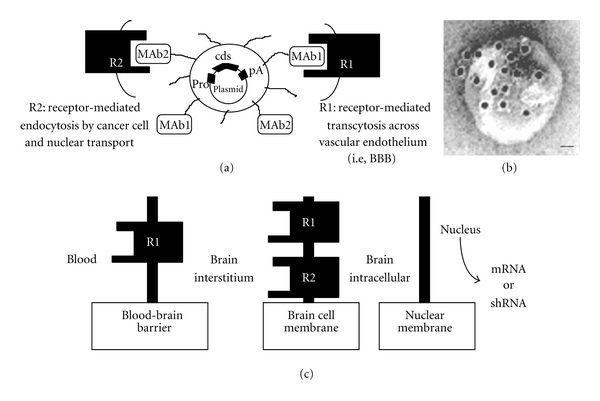Figure 1.

Engineering of Trojan horse liposomes (THL). (a) A supercoiled plasmid DNA is encapsulated in the interior of the THL. The plasmid encodes for a coding sequence (cds), the expression of which is under the influence of a promoter (pro), that is, SV40, and a polyadenylation sequence (pA). The surface of the liposome contains several thousand strands of 2000 Da polyethylene glycol (PEG) to stabilize the complex in blood. Approximately 1-2% of the PEG strands are conjugated with a targeting receptor- (R-) specific monoclonal antibody (MAb) (Table 1), which triggers transport of the THL across biological barriers in vivo. THLs are engineered with a single type of MAb to target both the BBB and brain cells in the same species. In an experimental mouse model of a human brain tumor, the THL is engineered with both the 8D3 mouse transferrin receptor (TfR) MAb (MAb1) to target the mouse BBB (i.e., R1) and the 8314 human IR MAb (MAb2) to target the human tumor cells (i.e., R2). Thus, the THL is transported through the mouse BBB via receptor-mediated transcytosis on the mouse TfR, and then through the intracranial human glioma cell membrane via endocytosis on the human insulin receptor. (b) Transmission electron microscopy of a THL. Mouse IgG molecules tethered to the tips of the PEG strands on the surface of the THL were detected with a conjugate of 10 nm gold and an antimouse secondary antibody. The position of the gold particles illustrates the relationship of the PEG-extended MAb and the liposome surface. Magnification bar = 20 nm. (c) The 3-barrier model for gene therapy of the brain. Following intravenous injection, the THL carrying the transgene must traverse 3 barriers in series to be able to reach the nucleus for expression: (a) the blood-brain barrier (BBB), (b) the brain cell membrane (BCM), and (c) the nuclear membrane. THLs can be engineered with a single type of MAb to target the same receptor in both the BBB and BCM (R1) or with 2 different MAbs to target different receptors at the BBB and the BCM, for example, R1 and R2, respectively. From [4].
